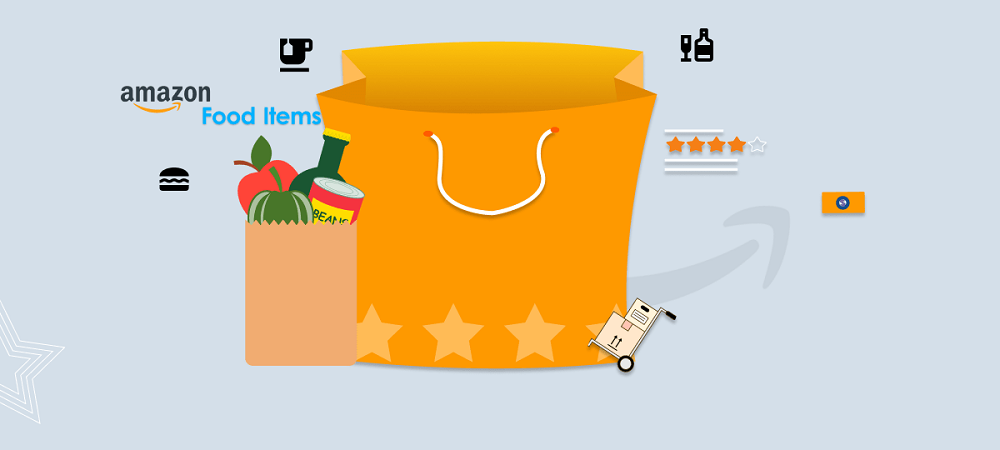Amazon Food-Selling Journey & Securing Approval
According to Statista, Amazon.com has risen to become the second-largest seller of food and drink products online, generating close to two billion dollars in revenue from this one market. Despite the possibility of making a sizable profit, selling food items on Amazon is sometimes perceived as a difficult process with obstacles that appear insurmountable.
However, armed with the proper perspective and a thorough strategy, this article seeks to answer the pertinent query: How to sell food on Amazon?

Unlocking the Path to Selling Food on Amazon
To begin the process of selling food products on Amazon, one must first take the preliminary step of signing up as a seller on the marketplace. This calls for creating an account, which is necessary to move on to the next phase.
Gaining Approval: A Step-by-Step Guide
- Stocking Up: It's essential to have an inventory stock before beginning any sales. There are two ways to do this: either add an offer for an already-existing product utilizing identification elements like barcodes or create a new product listing with images and descriptions. Each choice has particular criteria that must be carefully considered.
- Selection of Delivery Method: Three options are available for the shipping method: Easy Ship (ES), Fulfillment by Merchant (FBM), and Fulfillment by Amazon (FBA). Each choice requires certain handling techniques, with FBA providing the additional benefit of Prime shipping for increased product visibility.
- Ongoing Activities: Beyond approval, keeping a good Amazon presence requires controlling your brand identity, using sales tools to gather useful data, keeping an eye on inventory levels, and meticulously following food safety laws.
Groceries on Amazon: Compliance and Requirements
Although the aforementioned processes might appear simple, the landscape of selling food items is fraught with complexity because of the strict rules and storage requirements specific to the food sector. Particularly challenging are the grocery and gourmet food industries, which demand adherence to strict standards to maintain a selling presence.
Packaging, Shelf Life, Listing, and More!
- a) Packaging: Protecting goods from contamination requires effective packaging. It needs to hold up against things like spoiling, melting, damage, and exposure. Maintaining the interior temperature is essential for frozen and refrigerated foods, necessitating a strong "chill chain" technique.
- b) Shelf Life: In terms of customer pleasure and regulatory compliance, the shelf life or expiration date of items is crucial. A crucial necessity is to guarantee that products are delivered with a decent amount of shelf life left.
- c) Listing: Dietary claims, the labeling of customized variety packs, and other elements particular to different food kinds are all covered by listing regulations. To provide accurate and thorough product information, it is crucial to adhere to the grocery style standard.
- d) Shipping and Labeling: It's critical to provide accurate labeling that details dietary restrictions and unaltered expiration dates. Maintaining the packing's integrity while shipping necessitates paying close attention to potential problems with shelf life and packaging specifications.
Navigating Meat and Fruit Sales
The chances for selling vegetables and meat have risen as a result of Amazon's acquisition of Whole Foods. The viability, however, largely depends on proximity to Whole Foods locations and the challenges associated with shipping fresh goods. Fresh fruit and meat sales have certain restrictions and constraints, yet it is achievable with proper planning.
Understanding Food Category Fees
The chances for selling vegetables and meat have risen as a result of Amazon's acquisition of Whole Foods. The viability, however, largely depends on proximity to Whole Foods locations and the challenges associated with shipping fresh goods. Fresh fruit and meat sales have certain restrictions and constraints, yet it is achievable with proper planning. Sellers who want to sell food should be aware of the costs involved. These fees are arranged according to item pricing and are different for things costing $15 or less than those costing more than $15. Additionally, the cost structures for individual and professional vendors vary, with the latter paying a monthly subscription fee.
Challenges in Selling Food on Amazon
The journey of selling food items on Amazon is not without its challenges:
- a) Elevated Costs: Selling food items carries higher costs due to shipping and storage requirements, which can be especially demanding for perishable items.
- b) Stringent Requirements: The Food and Drug Administration (FDA) regulations play a pivotal role, necessitating adherence to stringent quality and transportation standards.
- c) Limited Time Frames: Food products have a limited shelf life, requiring efficient inventory management and monitoring.
- d) Quality Demands: The high standards in the food industry entail meticulous attention to detail in aspects like packaging, labeling, and adherence to dietary claims.
Best Practices for Successful Food Sales on Amazon
To excel in selling food on Amazon, consider these best practices:
- a) Thorough Understanding of Terms of Service: Familiarize yourself with Amazon's requirements, ensuring compliance at every stage.
- b) Research Country-Specific Requirements: Understand the regulations governing food shipments in your country to align with international standards.
- c) Start Small: Begin with non-perishable items to grasp the intricacies of the process before venturing into perishable goods.
- d) Wholesale Accounts: Start with wholesale products to reduce the complexity of regulations compared to private-label items.
- e) Accurate Claims: Avoid making false dietary or allergen claims, and ensure your product descriptions align with official standards.
Final Thoughts
Selling food items on Amazon is a journey marked by both challenges and opportunities. While the process demands meticulous adherence to regulations, quality standards, and logistical considerations, it offers the potential for significant rewards. By staying informed, adopting best practices, and embracing the complexity, sellers can carve a successful path in the thriving realm of online food sales.
If you need further assistance, just send an email to support@zonbase.com or use our Live Chat.
